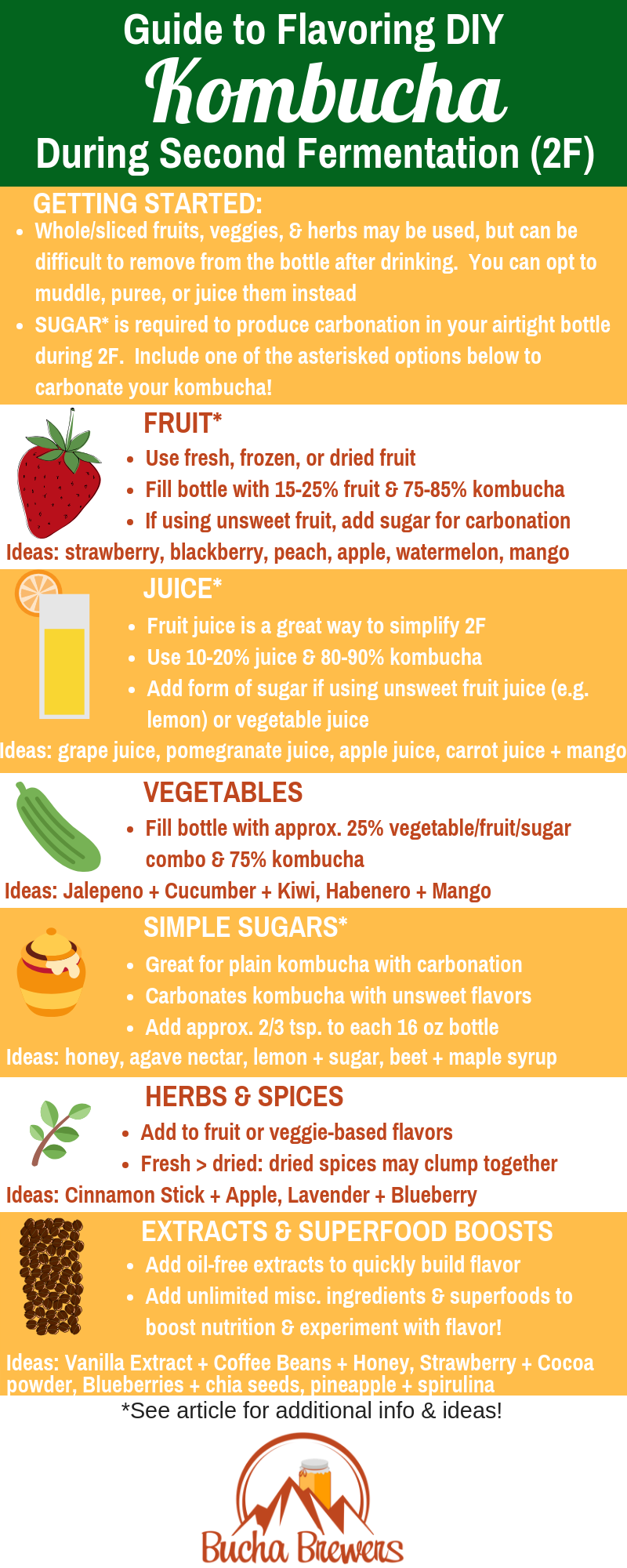
If you finished your first kombucha fermentation and you are looking for the best second fermentation kombucha recipes, you are in the right place! In this article, we will go through some of the best kombucha recipe flavors to give you some inspiration. If you are looking to have kombucha recipes and ingredients delivered to your door each month, check out our kombucha recipe subscription box!
Kombucha Recipes vs. Kombucha Recipe Flavors
Would you like to cut to the chase and check out some perfected, complete recipes? Head over to our recipe page! If you want to learn more about making your OWN second fermentation kombucha recipes, stick around. We will explore the best ingredients for your second fermentation kombucha, go over basic rules for flavoring your second fermentation kombucha, and finally work on flavor pairings to make the best kombucha you’ve ever had!
When Do I Flavor My Kombucha? Primary & Secondary Fermentation
During primary fermentation, the SCOBY (symbiotic culture of bacteria and yeast) will be placed in your brewing vessel along with starter tea and fresh sweet tea. SCOBYs are fragile, and thrive when kept in a clean environment with just their fuel (sweet tea). Adding anything else to your primary fermentation can and likely will harm your SCOBY.
Thus, you should not add any extra ingredients during the primary fermentation process. We also do not recommend using substitutes for cane sugar (such as honey or agave nectar) during the initial fermentation process. FORTUNATELY, your SCOBY is removed prior to second fermentation, allowing you to add just about any flavors and ingredients your heart desires! We repeat, you should only flavor your kombucha during second fermentation. If you are unclear on the difference between first and second fermentation, read this article on the entire fermentation process.
Why Isn’t My Kombucha Carbonated?
During primary fermentation, most of the carbonation created makes its way around your SCOBY and escapes through the uncovered jar. This is normal; primary fermentation does not result in a significant amount of carbonation. Unfortunately, since primary fermentation is aerobic (requires oxygen), it is necessary to let your jar “breath” and thus lose most of your carbonation.
However, second fermentation is an anaerobic process. You will use an airtight container for second fermentation, and will therefore trap most of the carbonation within the container. In short, the carbonation kombucha is famous for is almost entirely created during the second fermentation process. If you choose not to do second fermentation, you kombucha will not be very carbonated or “bubbly”. If you are going through second fermentation and still not getting the carbonation you desire, troubleshoot with this article.
What Do I NEED to add during second fermentation?
If you want carbonated kombucha, you need to add a form of SUGAR to your second fermentation kombucha bottles. Otherwise, there is nothing that you need to add—it is just a matter of picking the flavors you want. We recommend adding about 1 tsp of organic cane sugar to each 16 ounce bottle OR adding the sugar equivalent in the form of fruit, fruit juices, etc.
What NOT to add during second fermentation
If you remember one rule for your second fermentation additions, it should be to add FRESH ingredients. Fruits, vegetables, herbs, and extracts are best. Do NOT add artificial flavoring or oils—they can keep your kombucha from getting carbonated. Do NOT add excessive amounts of sugar; too much sugar can result in too much carbonation, which could cause your bottle to explode.
You can use fresh, dried, juiced, pureed, or any other form of the fruits/vegetables/herbs/etc. you choose, but your kombucha will turn out best if you use natural ingredients. For that reason, we will help spark your recipe combo creativity using various natural ingredients!

Kombucha Recipe Flavors
When creating kombucha recipes, we first think of involving something that contains enough sugar to create carbonation. Then, we think about whether there are any herbs or vegetables we would like to add. Finally, we take a look at miscellaneous add-ins. Let’s take a look at some popular examples in each category.
Sugar
Strawberries, apples, pears, peaches, nectarines, plums, watermelon juice, blackberries, blueberries, raspberries, pineapple, goji berries, apricots, pomegranate juice, orange juice, grapefruit juice, grapes, mangoes, cane sugar, brown sugar, honey, agave nectar, maple syrup, coconut, kiwi, papaya, currant, tamarind, & passionfruit
Herbs, Roots, & Extracts
Lavender, hibiscus, rosehips, vanilla, elderberry, lemongrass, ginger, basil, mint, cinnamon, rosemary, thyme, cilantro, turmeric, anise, nutmeg, allspice, & lemon balm
Vegetables & Sugar-Free Fruit
Lemon, Lime, cucumber, jalapeño, beet, carrot, kale, celery
Misc.
Coffee beans, chia seeds, cocoa powder, spirulina
Pairing Ingredients
The above examples are just that: examples! They sky is the limit when it comes to flavoring your kombucha, and you can add just about anything to your second fermentation kombucha recipes. The infographic at the beginning of this article conveys the basics of flavoring your kombucha, and it also provides some examples for recipe combinations.
If you are looking for additional examples of kombucha recipe flavor pairings, check out our recipe page.
If you decide the recipe creation isn’t for you, consider subscribing to our kombucha second fermentation recipe box. Have a delicious new recipe and all of the ingredients you need delivered to your door each month!
We hope this article has been helpful for you on your second fermentation kombucha journey! Feel free to share any questions or comments below.






[…] can be somewhat polarizing. This comes from the organic acids present in kombucha. Kombucha can also be flavored with juice, fruit, herbs, and more! As a result, you can make your kombucha taste like just about anything when you brew your […]
When I try using fresh herbs (lemon balm, basil, peppermint) in second fermentation, the leaves turn brown. Is this bad?
Hi there, it is normal and natural to experience these color changes during fermentation! It does not look pretty, but it is normal and nothing to worry about. Happy Brewing!